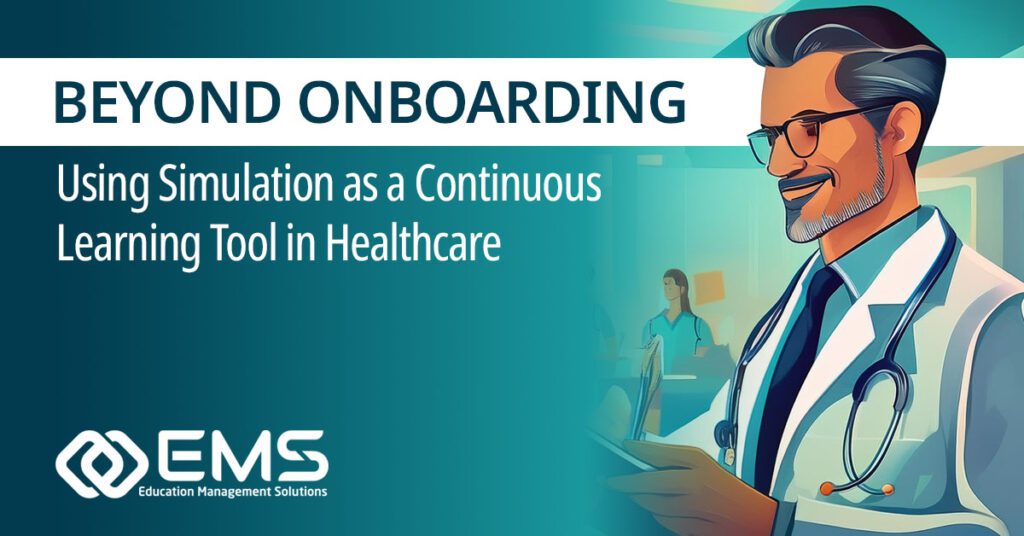If there’s one constant in healthcare, it’s change. New treatments, evolving technologies, and revised protocols require healthcare professionals to be in a continuous state of learning.
However, while traditional onboarding programs are critical for bringing new employees up to speed, they often lack the structure to support ongoing professional development. Nonetheless, learning cannot stop after orientation. To remain effective, healthcare professionals must be equipped with tools to facilitate continuous education throughout their careers.
Simulation-based training solutions address both the need for continuous skills development and the demand for greater flexibility. With advancements in technology, simulation platforms can now be accessed remotely, enabling learning anytime, almost anywhere. This flexibility makes simulation-based education particularly valuable in today’s healthcare environment, where time and resources are often limited.
Continuous Professional Development, Not One-Off Onboarding, Is a Must
Healthcare is a highly dynamic industry, requiring professionals to maintain and enhance their skills throughout their careers. New protocols and technologies can emerge at any time, and regulatory bodies often mandate ongoing education to ensure patient safety.
However, traditional onboarding as a “one and done” activity is insufficient. Once initial training is complete, clinicians must continue learning to keep pace with evolving standards. Continuous professional development not only ensures compliance, but also enhances job satisfaction by fostering career growth and improving patient outcomes.
The Limitations of Traditional Onboarding
While essential, traditional, often-classroom-based onboarding presents several limitations:
Time-Intensive
Employees can spend weeks participating in structured training programs, pulling them away from patient care and straining already-stretched healthcare teams. This downtime can lead to staffing shortages, leaving fewer hands on deck and increasing the workload on remaining staff, which can compromise both morale and patient outcomes.
Lack of Personalization
One-size-fits-all programs may fail to address the specific needs of individual learners or the specialized requirements of different departments and roles. For example, a general training curriculum might not adequately prepare a nurse transitioning into a high-acuity area such as intensive care.
Inconsistent Training Quality
Differences in teaching styles, program structures, and access to resources across trainers can result in inconsistent staff preparedness. Particularly in multi-location healthcare systems, this variability can directly impact the quality of patient care across departments.
Limited Retention and Skill Decay
Onboarding programs often cover a lot of ground over a short period. Without opportunities for continuous reinforcement, staff members may forget key procedures or protocols over time. This potential skill decay is particularly concerning for infrequently performed tasks, such as emergency interventions, which require both competence and confidence to execute effectively.
Passive Learning Methods
Traditional onboarding often relies on lectures, videos, and manuals, which engage learners passively. Research shows that active, hands-on learning—such as that provided by simulation training—leads to better knowledge retention and skill acquisition. Passive methods can fail to prepare staff adequately for the complexities of real-world healthcare settings, where critical thinking and quick decision-making are essential.
These challenges highlight the need for more agile, interactive, and personalized approaches to education—areas where simulation-based training excels.
Simulation Training Present Key Advantages Over Traditional Methods of Healthcare Instruction
Simulation-based training offers significant advantages over traditional methods by creating safe, immersive environments where healthcare professionals can practice both routine and high-stakes scenarios. These scenarios range from routine tasks, like medication administration, to life-or-death emergencies, such as managing cardiac arrests.
Advancements in technology, including advanced simulation management solutions, virtual reality (VR), and augmented reality (AR), further enhance the impact of simulation training by creating immersive, high-fidelity clinical environments.
These tools allow healthcare professionals to practice decision-making in realistic, dynamic scenarios. With real-time feedback, participants can immediately see the outcomes of their actions, reinforcing critical skills and building confidence for high-pressure situations.
Simulation also strengthens teamwork and communication, both of which are essential to patient safety. In fact, a report by the Joint Commission Internal found that as many 80% of medical errors stem from communication breakdowns within healthcare teams.
Simulation-based exercises provide a controlled environment for team members to better understand their roles and responsibilities, improve communication strategies, and coordinate their efforts seamlessly, resulting in fewer errors in real clinical settings.
Four Benefits of Simulation-Based Learning
- Increased Competency and Confidence: Professionals trained through simulation achieve higher procedural success rates and encounter fewer complications compared to those trained through traditional methods.
- Risk Reduction: Simulation enables healthcare providers to practice high-risk scenarios without endangering patients. This training ensures readiness for real-world emergencies and can help organizations identify process weaknesses before they lead to adverse events.
- Cost Efficiency: By reducing the need for full-time educators and minimizing costly off-site programs, simulation improves operational efficiency. Additionally, fewer errors means lower liability and healthcare costs over time.
- Regulatory Compliance: Many accrediting bodies now mandate simulation-based learning for healthcare professionals. Simulation platforms that track learner performance help organizations meet these requirements and provide valuable data for audits, accreditation, internal reviews, and mitigation efforts.
Empowering Lifelong Learning with Healthcare Simulation Training
Simulation-based training extends learning beyond the onboarding phase, transforming it into an ongoing process that evolves alongside the healthcare industry. By offering immersive, flexible, and effective training solutions, simulation helps healthcare professionals remain competent and confident, reducing risks and improving patient care.
As healthcare continues to evolve, institutions must embrace innovative training solutions to keep pace. Simulation is no longer a luxury but a necessity for ensuring safe, effective care.
Whether enhancing your onboarding program or fostering a continuously learning workforce, EMS’s simulation solutions equip your team to adapt, grow, and achieve better patient outcomes.
Schedule a demo to explore how we can help your organization stay ahead.

